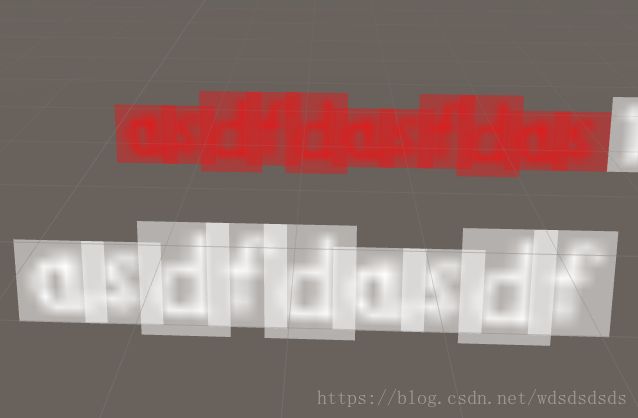Unity内置Shader-Text Shader(3DText)
// Unity built-in shader source. Copyright (c) 2016 Unity Technologies. MIT license (see license.txt)
Shader "GUI/Text Shader" {
Properties {
//这里的贴图为字体里面的FontTexture
_MainTex ("Font Texture", 2D) = "white" {}
_Color ("Text Color", Color) = (1,1,1,1)
}
SubShader {
Tags {
//渲染队列-通常这个索引用来渲染透明度混合的物体
"Queue"="Transparent"
//Projector为投影器,这样设置将会使该物体忽略任何投影类型的材质或贴图的影响
"IgnoreProjector"="True"
//渲染透明物体时使用
"RenderType"="Transparent"
//预览-平面
"PreviewType"="Plane"
}
//关闭光照 剔除关闭(正背面全部显示) 深度测试开启 深度写入关闭
//深度测试为当这个物体比深度缓冲中的像素靠近摄像机时显示,否则不显示
Lighting Off Cull Off ZTest Always ZWrite Off
//以这个物体的a值为标准,设置颜色缓冲区中的颜色为1-这个物体的a值
Blend SrcAlpha OneMinusSrcAlpha
//这里总体设置为不受光照影响,全部渲染。透明处理为打开深度测试,关闭深度写入自己定义颜色混合(以该物体a值为标准)
Pass {
CGPROGRAM
#pragma vertex vert
#pragma fragment frag
//大概就是vr ar,xr之类的东西了
//https://docs.unity3d.com/Manual/SinglePassStereoRendering.html
#pragma multi_compile _ UNITY_SINGLE_PASS_STEREO STEREO_INSTANCING_ON STEREO_MULTIVIEW_ON
#include "UnityCG.cginc"
struct appdata_t {
float4 vertex : POSITION;
fixed4 color : COLOR;
float2 texcoord : TEXCOORD0;
UNITY_VERTEX_INPUT_INSTANCE_ID
//UnityCG.cginc-UnityInstancing.cginc
//- UNITY_VERTEX_INPUT_INSTANCE_ID Declare instance ID field in vertex shader input / output struct.在a2v或者v2f里面声明id领域
// #ifdef SHADER_API_PSSL
// #define DEFAULT_UNITY_VERTEX_INPUT_INSTANCE_ID uint instanceID;
// #else
// #define DEFAULT_UNITY_VERTEX_INPUT_INSTANCE_ID uint instanceID : SV_InstanceID;
// #endif
};
struct v2f {
float4 vertex : SV_POSITION;
fixed4 color : COLOR;
float2 texcoord : TEXCOORD0;
UNITY_VERTEX_OUTPUT_STEREO
//UnityCG.cginc-UnityInstancing.cginc
//- UNITY_VERTEX_OUTPUT_STEREO Declare stereo target eye field in vertex shader output struct.
// #ifdef UNITY_STEREO_INSTANCING_ENABLED
// #define DEFAULT_UNITY_VERTEX_OUTPUT_STEREO uint stereoTargetEyeIndex : SV_RenderTargetArrayIndex;
// #elif defined(UNITY_STEREO_MULTIVIEW_ENABLED)
// #define DEFAULT_UNITY_VERTEX_OUTPUT_STEREO float stereoTargetEyeIndex : BLENDWEIGHT0;
// #endif
};
sampler2D _MainTex;
uniform float4 _MainTex_ST;
uniform fixed4 _Color;
v2f vert (appdata_t v)
{
v2f o;
UNITY_SETUP_INSTANCE_ID(v);
// - UNITY_SETUP_INSTANCE_ID Should be used at the very beginning of the vertex shader / fragment shader,
// #define DEFAULT_UNITY_SETUP_INSTANCE_ID(input) { UnitySetupInstanceID(UNITY_GET_INSTANCE_ID(input));
// void UnitySetupInstanceID(uint inputInstanceID)
// {
// #ifdef UNITY_STEREO_INSTANCING_ENABLED
// // stereo eye index is automatically figured out from the instance ID
// unity_StereoEyeIndex = inputInstanceID & 0x01;
// unity_InstanceID = unity_BaseInstanceID + (inputInstanceID >> 1);
// #else
// unity_InstanceID = inputInstanceID + unity_BaseInstanceID;
// #endif
// }
UNITY_INITIALIZE_VERTEX_OUTPUT_STEREO(o);
//o.stereoTargetEyeIndex = unity_StereoEyeIndex
//顶点坐标从模型空间(M)转换到观察空间(v,摄像机空间) 等同mul(Unity_MARTIX_MVP, v.vertex)
o.vertex = UnityObjectToClipPos(v.vertex);
//因为3dText的网格顶点是由TextMesh生成,TextMesh可以调整顶点颜色,这样可以使用TextMesh调整每个3d字体的特殊颜色,_Color确定总体颜色
o.color = v.color * _Color;
//UnityCG.cginc #define TRANSFORM_TEX(tex,name) (tex.xy * name##_ST.xy + name##_ST.zw)
//主要计算_MainTex的tilling和offset但是感觉这个shader里面没有卵用。真的有人调整这个吗
//感觉可以直接 o.texcoord = v.texcoord
o.texcoord = TRANSFORM_TEX(v.texcoord,_MainTex);
return o;
}
fixed4 frag (v2f i) : SV_Target
{
fixed4 col = i.color;
col.a *= tex2D(_MainTex, i.texcoord).a;
// col.a = (col.a + tex2D(_MainTex, i.texcoord).a)/2;
return col;
}
ENDCG
}
}
}
#UNITY_INITIALIZE_VERTEX_OUTPUT_STEREO
这个shader里面的几个宏
UNITY_INITIALIZE_VERTEX_OUTPUT_STEREO(o);
//o.stereoTargetEyeIndex = unity_StereoEyeIndex实现这个变量的赋值,应该是vr里面需要的,双眼效应。手游及pc上没有效果。。我感觉。https://unity3d.com/cn/unity/qa/patch-releases/5.6.0p3
col.a *= tex2D(_MainTex, i.texcoord).a;
混合两个颜色这里使用了用两个颜色相乘,我感觉也可以col.a = (col.a + tex2D(_MainTex, i.texcoord).a)/2;像这样相加除以2,但是结果并不是很好
 这里应该是TextMesh生成网格时并不是只生成了这几个字符的网格,在外面还有矩形的网格,因此用相乘的方法可以很好的解决这个问题,因为图片的四角a值为0,所以相乘之后很完美。
这里应该是TextMesh生成网格时并不是只生成了这几个字符的网格,在外面还有矩形的网格,因此用相乘的方法可以很好的解决这个问题,因为图片的四角a值为0,所以相乘之后很完美。
UnityObjectToClipPos(vertex)
这个方法是最近unity刚更新的,在UnityShaderVariables.cginc可以找到定义
// Unity built-in shader source. Copyright (c) 2016 Unity Technologies. MIT license (see license.txt)
#ifndef UNITY_SHADER_UTILITIES_INCLUDED
#define UNITY_SHADER_UTILITIES_INCLUDED
// This file is always included in all unity shaders.
#include "UnityShaderVariables.cginc"
// Tranforms position from object to homogenous space
inline float4 UnityObjectToClipPos(in float3 pos)
{
// More efficient than computing M*VP matrix product
return mul(UNITY_MATRIX_VP, mul(unity_ObjectToWorld, float4(pos, 1.0)));
}
inline float4 UnityObjectToClipPos(float4 pos) // overload for float4; avoids "implicit truncation" warning for existing shaders
{
return UnityObjectToClipPos(pos.xyz);
}
#endif
mul(UNITY_MATRIX_VP, mul(unity_ObjectToWorld, float4(pos, 1.0)));
这个东西不是很理解为什么不像之前直接mul(UNITY_MATRIX_MVP,v.vertex);需要先乘m再乘vp